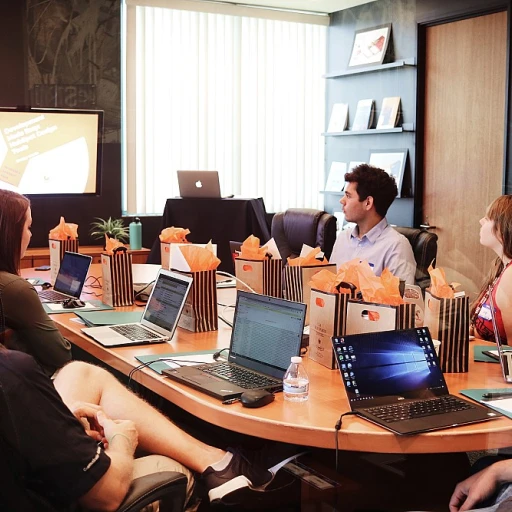-teaser.webp)
Understanding Workforce Planning
The Foundations of Workforce Strategy
In today's ever-evolving business environment, understanding workforce planning becomes a critical function for companies aiming to gain a competitive edge. At its core, effective workforce planning involves strategically hiring, training, and deploying talent to align with the organization's goals. This not only addresses current job demands but also prepares the company for future workforce challenges.
To begin with, a comprehensive workforce strategy requires identifying key roles and assessing the existing talent pool. It's about understanding where there are skills gaps and how these can be filled with diverse or emerging talent. Companies must evaluate their hiring and recruitment processes to ensure they attract job-ready candidates who can adapt to various roles.
Incorporating an effective hiring model is crucial to improve recruitment outcomes. Traditional recruitment methods may need a shift towards more tech-driven strategies. This could involve utilizing data analytics to predict workforce needs or employing digital platforms to enhance candidate engagement. Having a robust recruitment process ensures that companies not only hire talent but also foster a diverse and skill-rich workforce.
Moreover, designing a dynamic training program is essential to mitigate skills gaps and prepare employees for evolving tech roles. The emphasis here is on skill development, where ongoing skills training and upskill models are introduced to ensure the workforce remains agile, innovative, and ready to tackle new challenges.
Deploying this talent efficiently requires a well-structured deploy model. It ensures that employees are allocated effectively across projects, aligning their skills with the organization's goals. This deployment model not only optimizes talent use but also enhances productivity and job satisfaction.
Ultimately, the success of workforce planning lies in its ability to anticipate and adapt to change, making it a cornerstone strategy for companies in navigating the future of work.
Effective Hiring Strategies
Strategic Recruitment Approaches
When it comes to building a dynamic and efficient workforce, effective recruitment strategies are paramount. Companies today are not merely looking to fill positions, but are leveraging advanced hiring models to bridge skills gaps and bolster their talent pool. Here are some approaches that can transform your recruitment process:
- Adopt Emerging Technologies: Integrating technology into recruitment processes can streamline operations, making it easier to sift through candidates and identify suitable tech talent efficiently. Utilization of tools like AI can mitigate bias and enhance decision-making capabilities.
- Focus on Diverse Talent: Diversity initiatives are more than a trend; they're a strategic asset. A workforce composed of diverse individuals brings varied perspectives and innovation, crucial for tackling complex challenges. Recruitment should actively pursue this depth of talent.
- Tapping into Talent Networks: Building and nurturing a network of potential candidates ensures you have access to a readily available talent pool. This proactive approach can save time and resources, making the hiring process significantly more cost-effective.
- Utilize a Deploy Model: Instead of traditional recruitment methods, consider using a hire, train, and deploy model. This allows companies to recruit talent based on potential rather than current skills, followed by skills training to make them job ready. Such an approach aligns the workforce needs more closely with the company's strategic goals.
The integration of these strategies not only aids in recruiting talented individuals but also prepares the organization to efficiently respond to global mobility challenges and helps in making informed decisions regarding talent mobility.
Training for Skill Development
Enhancing Skills Through Tailored Programs
In today's fast-paced business environment, continuous skill development is crucial for companies looking to remain competitive. Effective training for skill development is not just about imparting knowledge; it's about creating a tailored training program that addresses specific skills gaps within your workforce. Crafting a training program starts with identifying what skills your team currently possesses and where the gaps lie. Companies often utilize a skills gap analysis to determine which skill areas need reinforcement, enabling them to create targeted training initiatives. This strategic approach ensures that resources are used effectively and employees become job ready.Adopting Innovative Training Models
Tailoring the approach to training means being open to varied models such as the HTD (hire, train, deploy) model. The HTD model is an integrated approach that allows companies to hire emerging talent, train them with precise skills, and swiftly deploy them into relevant roles. This method is cost effective as it reduces the dependency on traditional recruitment processes and helps build a capable in-house talent pool. Digital skills are particularly in demand, so incorporating tech talent and digital skills training into your programs can be a game-changer. The rise of online training platforms and resources offers greater flexibility and accessibility for employees to learn at their own pace, making it easier to accommodate diverse talent in an organization.Fostering an Environment for Continuous Learning
Companies should aim to create a culture that values continuous learning. Encouraging employees to take part in ongoing training not only boosts their confidence but also enhances their capability to contribute effectively to the organization. It's about nurturing a mindset that is receptive to change and innovation, ultimately leading to a robust and agile workforce. Moreover, consider incorporating corporate wellness retreats into your training programs. These retreats can play a significant role in promoting overall employee well-being, which is closely tied to productivity and retention rates. In essence, training for skill development is more than a mere function within the company; it is a strategic pillar that supports the organization's growth and adaptability. Whether through targeted training initiatives, innovative skill-building models, or fostering learning environments, addressing skills development sets the stage for successfully deploying trained talent across varied roles.Deploying Talent Efficiently
Maximizing Talent Deployment
Effective deployment of talent is a cornerstone of successful workforce planning. After a company has gone through the hiring and training phases, ensuring that these efforts translate into real organizational effectiveness is crucial. Deploying talent efficiently focuses on aligning employees' skills and roles to the company's strategic goals. The importance of a well-structured deploy model cannot be overstated. This model ensures that talent, particularly tech talent, is placed in positions where they can maximize their capabilities. By leveraging a deploy program, companies can address any skills gap within their team. This process involves evaluating each employee's skills and matching them with the respective job roles, ensuring that each member is job-ready to face emerging challenges. Companies need to adopt a dynamic approach to workforce deployment, which includes:- Asses and Allocate: Conduct regular assessments of workforce skills to align them with current and future strategic needs. Use these assessments to guide the allocation of roles and responsibilities, ensuring each employee’s skills fit the roles they are deployed into.
- Continuous Skill Development: After deployment, continuous skills training should be part of the htd model. This training ensures employees remain adaptable and continue to fill the evolving skill requirements of their roles.
- Feedback and Adjustment: Encourage an open feedback culture. Employees should be able to express where they feel their skills could be better utilized, and managers should be able to make adjustments to roles and responsibilities as needed.
Overcoming Challenges in Workforce Planning
Addressing Key Obstacles in Workforce Strategies
Workforce planning is not without its set of hurdles. As companies aim to master the art of hiring, training, and deploying talent, several challenges often emerge. Understanding these obstacles is crucial in implementing effective workforce strategies.
Bridging the Skills Gap
One of the most persistent issues in workforce planning is the skills gap. With rapid technological advancements, the demand for digital skills has skyrocketed, leaving many organizations struggling to find 'job ready' candidates. Incorporating a robust training program can help address this gap by equipping employees with necessary digital skills, ensuring they remain competitive and effective in their roles.
Diversifying Talent Pools
Another challenge is ensuring diversity in the talent pool. Diverse teams have been shown to drive innovation and better decision-making in companies. However, traditional recruitment methods may not always effectively tap into emerging and diverse talent. Companies can overcome this by adopting inclusive hiring practices and expanding their recruitment channels to reach a wider and more varied candidate pool.
Adapting to Technological Shifts
The rise of tech talent has introduced additional complexities in workforce planning. Companies need to be agile in adopting new technologies and ensure their workforce is continuously trained to adapt to evolving tech landscapes. This requires a forward-thinking approach and investment in continuous learning initiatives that support a dynamic workforce.
Implementing Cost-Effective Deployment Models
Deploying talent efficiently while keeping costs down is a delicate balancing act. The "hire, train, deploy" (HTD) model can be a cost-effective solution for companies seeking to maximize their workforce strategies. By efficiently hiring, training, and then deploying talent where they are most needed, organizations can maintain flexibility and drive productivity.
Fostering Team Collaboration
Collaboration within teams can often be hampered by poor communication and siloed operations. Encouraging open communication and a collaborative mindset within the workforce can overcome these challenges. Implementing team-building activities and fostering a culture of inclusivity is essential to create a cohesive work environment.
Successfully navigating these challenges requires strategic insight and a willingness to adapt to changing workforce dynamics. Companies that tackle these issues head-on are more likely to excel in hiring, training, and deploying talent effectively.
Future Trends in Workforce Planning
Adapting Workforce Planning to the Upcoming Shifts
In an ever-evolving workforce landscape, companies face the task of fine-tuning their workforce planning strategies to address emerging trends. These changes necessitate a flexible approach in hiring, training, and deploying talent to ensure organizations remain competitive.Emphasis on Digital Skills and Tech Talent
As technology continues to reshape industries, the demand for tech talent has surged. Organizations must adapt their workforce planning to hire and train individuals with digital skills. By identifying skills gaps early and implementing training programs tailored to bridging those gaps, companies can ensure their teams are well-equipped to meet future demands.Shift Towards a More Diverse Talent Pool
Workforce diversity is becoming increasingly important. Companies are recognizing the value of diverse talent and its positive impact on creativity and problem-solving. Recruit and hire with diversity in mind, and you'll enhance your company's adaptability and innovation. Deploying a diverse talent model also aids in cultivating a work environment that reflects the society it serves.Adoption of the HTD Model
The Hire-Train-Deploy (HTD) model has gained traction as a cost-effective strategy to build a job-ready workforce. By integrating this approach, companies can focus on recruiting promising candidates who may not fit traditional hiring criteria but who possess the potential for growth. After appropriate training, these individuals can be deployed effectively into various roles, minimizing the skills gap.Integration of Advanced Tech in Workforce Planning
Advancements in technology are not just influencing the type of skills needed but are also playing a crucial role in how workforce planning is executed. Utilizing data analytics and AI in the recruitment and team deployment processes allows for more effective decision-making, ensuring the right talent is hired, trained, and deployed efficiently.As we look to the future, workforce planning will continue to evolve, driven by technological advancements and changing demographics. Companies that stay ahead by embracing these trends will be best positioned to succeed in an increasingly competitive marketplace.














